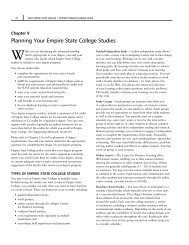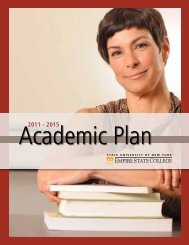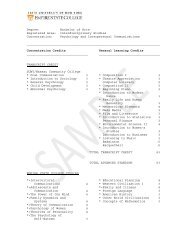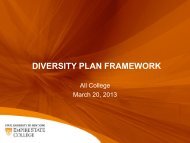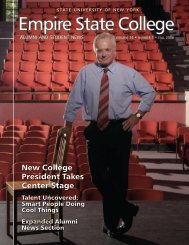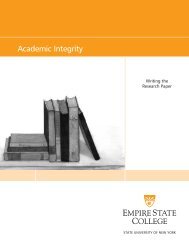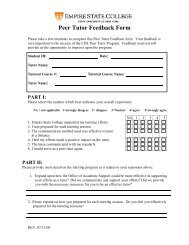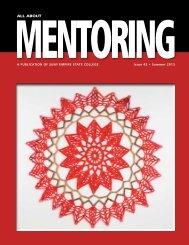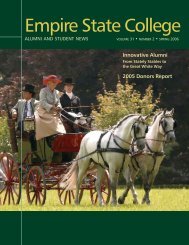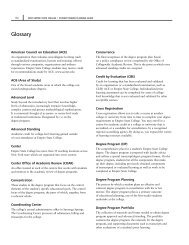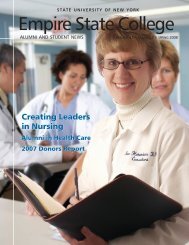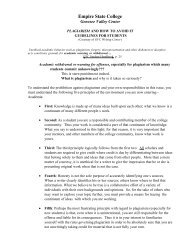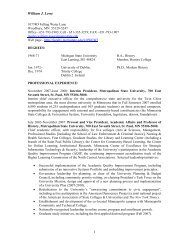All About Mentoring Spring 2011 - SUNY Empire State College
All About Mentoring Spring 2011 - SUNY Empire State College
All About Mentoring Spring 2011 - SUNY Empire State College
You also want an ePaper? Increase the reach of your titles
YUMPU automatically turns print PDFs into web optimized ePapers that Google loves.
32<br />
As we look to expand the definition of<br />
blended learning, taking into account the<br />
21st century learner, we explored some<br />
of the ways that we “blend” in the online<br />
environment. We approached our task by<br />
inviting colleagues to share, in their own<br />
words, how they think about and integrate<br />
blended learning in the studies that they<br />
create and/or teach. These examples span<br />
various areas of study and, as will become<br />
evident, use different approaches to online<br />
blended learning.<br />
Blended Learning: Online and<br />
Community-based (Example 1) –<br />
Tom Mackey<br />
This term, I am working with a student<br />
on an independent study on social and<br />
community informatics. The open learning<br />
environment at <strong>Empire</strong> <strong>State</strong> <strong>College</strong><br />
encourages this kind of exploration with<br />
experimental modes of learning, in this<br />
case, a study co-designed with the student.<br />
This is a course that I originally developed<br />
in 2007 for the Honors <strong>College</strong> at the<br />
University at Albany. I happened to mention<br />
my experience teaching this course in a<br />
blog posting and one of my students in<br />
Digital Storytelling was intrigued by the<br />
idea, expressing interest in doing something<br />
similar at CDL. This student is engaged<br />
with her community and contributes in<br />
many ways through food drives and other<br />
volunteer work. She was interested in<br />
the idea of a course that required service<br />
learning, an activity that she was already<br />
involved in, and would allow her to blend<br />
theory and practice in a meaningful way.<br />
For this study, the student blogs about<br />
theoretical readings related to social and<br />
community informatics and she conducts<br />
service learning in her community,<br />
reflecting on the readings and bringing<br />
these insights to her observations. She also<br />
conducts a structured field study, where<br />
she analyzes the organization from a social<br />
and community informatics perspective<br />
and identifies a need that then impacts her<br />
work at the community location. The blend<br />
occurs on several levels – blending theory<br />
and practice, in place and online learning,<br />
individual and collaborative practice, course<br />
work and service, and integrating a range<br />
of hybrid technologies to tell her story and<br />
to contribute to the technology needs and<br />
strategic planning of the organization.<br />
Blended Learning: Online and<br />
Community-based (Example 2) –<br />
Joyce McKnight<br />
I think my Community Organizing course at<br />
CDL is a good example of blended learning,<br />
as well as of service learning. It contains<br />
the usual asynchronous discussions and<br />
written assignments. I [also] use Elluminate<br />
[a virtual learning environment] for weekly<br />
online conversations. I frequently talk<br />
with students on the telephone about their<br />
individual projects; and, almost every<br />
semester, one or two students do face-toface<br />
things with and for the on-ground<br />
community organizing projects I am<br />
doing. For instance, in spring 2010, one<br />
of my students built a balloon dart board<br />
for a Kids Carnival we had for the Teen<br />
Connection [program], and came up<br />
from near New York City with his wife<br />
and family to run it. This semester, a<br />
Schenectady student has joined at least<br />
two of the neighborhood organizations<br />
there and has been doing very valuable<br />
volunteer work.<br />
Blended Learning: Online and<br />
Hands-on (Example 3) – Ken Charuk<br />
and Mary Mawn<br />
The Science of Cooking is a fully online<br />
course that takes a unique approach to<br />
blended learning. In this course, students use<br />
hands-on laboratory activities performed<br />
with common household items and<br />
ingredients in the student’s own kitchen<br />
to explore the science of cooking. These<br />
activities are designed to make connections<br />
between theory and practice, and offer<br />
students different ways to connect with the<br />
course content beyond an exclusive printedword<br />
learning style. Authentic, everyday<br />
activities such as browning meat and<br />
kneading dough help students understand<br />
the underlying biological, chemical and<br />
physical concepts and processes. This<br />
blending of theory and practice, text and<br />
hands-on is intended to promote deeper<br />
learning, as well as the understanding that<br />
science impacts everyone’s lives.<br />
Blended Learning: Online and<br />
Virtual (Example 4) – Audi Matias<br />
Many higher education institutions,<br />
particularly those involved in online<br />
learning, have discovered the great potential<br />
that virtual environments, such as Second<br />
Life (SL), brings to their programs. In the<br />
interdisciplinary, online course The Future of<br />
Being Human, we use SL to create a blended<br />
learning approach that provides students<br />
with a supported, constructive learning<br />
experience. A series of activities utilizing<br />
SL are scaffolded throughout the course in<br />
order to help students with the technology;<br />
in addition, the instructor meets on a regular<br />
basis, virtually, with the students. As with<br />
any experiment, students approach the<br />
SL activities using the scientific method.<br />
For the final SL-based learning, they are<br />
required to develop two hypotheses before<br />
they start their experiment, [each including:<br />
a description of] the world(s) they expect<br />
to see, the technologies they chose to use,<br />
and their experience as an avatar. Then,<br />
they participate in the activity, making<br />
observations based on their two hypotheses.<br />
This addition of a virtual meeting space<br />
component is a great gateway for students<br />
and instructors to come together, despite<br />
the physical constraints, to reflect on<br />
educational materials and subject content.<br />
Blended Learning: Online and Fieldbased<br />
(Example 5) – Phil Ortiz<br />
In Marine Biology, students are asked to<br />
spend some time at the Maritime Aquarium<br />
at Norwalk (CT). Although they don’t<br />
interact with their course instructor while<br />
there, they do meet with the members of<br />
the team of folks who helped develop some<br />
aspects of the course (who also appear on a<br />
DVD that was produced for the course).<br />
Blended Learning: Online, Fieldbased,<br />
and Virtual (Example 6) –<br />
Sheila Marie Aird and Mitchell<br />
Wood<br />
In Public History: A Shared Conversation<br />
(to be offered starting in fall <strong>2011</strong>), an<br />
advanced course, students will explore the<br />
concepts and practices of public history.<br />
Students will explore and critique diverse<br />
media, including film and websites, oral<br />
history collections and photographs.<br />
suny empire state college • all about mentoring • issue 39 • spring <strong>2011</strong>




